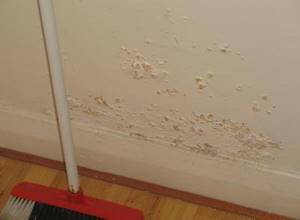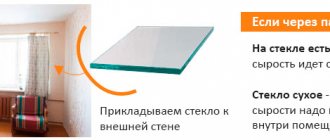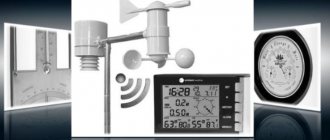A healthy microclimate in a home is a mandatory condition; it alone guarantees good health and the absence of any health problems for the owners. Unfortunately, apartment owners are often faced with dry air or, conversely, extremely high humidity, which is also detrimental to humans and dangerous for finishing materials, furniture and things. The first can be eliminated by purchasing a humidifier, but what to do with the second? First you need to identify the culprit of the problem, and then try to quickly eliminate it. There are several good ways to get rid of humidity in an apartment. To get results in the shortest possible time, a combination of several methods is possible.
How to reduce indoor humidity
Identify the source of dampness in your home and take steps to eliminate it. You can dry the air in your apartment with the help of specialists:
- call a plumber;
- call a specialist to repair or install a high-quality heating system;
- order wall insulation from the outside;
- order repairs and installation of window panels;
- hire a professional to repair or install a high-quality hood;
- Call a professional to seal seams or cracks.
You can eliminate the remaining reasons and dry the air in the room yourself:
- do frequent ventilation;
- dry your clothes on the balcony or outside;
- buy a dehumidifier;
- buy dehumidification tablets;
- buy an additional device for heating the room;
- If possible, allow natural sunlight into the room.
Do you know what the optimal humidity should be in a children's room? If not, here is a useful one
article on this topic
. And we also have a detailed article about
humidity standards in the apartment
.
Why is it worth drying out too humid air?
High humidity leads to the appearance of fungus in the house. Its spores are carried through the air, penetrating the lungs of the inhabitants and guests of the house. This causes rhinitis and asthma. If you live permanently in such unfavorable conditions, you are likely to suffer from chronic rhinitis, migraines, and disturbances in the functioning of the cardiovascular system. But there is no need to panic, in most cases you can successfully reduce the humidity.
In room
When purchasing or renting premises for storage, commercial or other purposes, you need to maintain its original condition. Only in this case will it be preserved and last a long time. If the level of moisture in the room has increased, but the owner does not pay attention to it, he dooms himself to subsequent additional expenses. As soon as the first signs of a change in the microclimate are noticed, it is necessary to solve the problem at the beginning of its occurrence, and not when the walls are already covered with fungi.
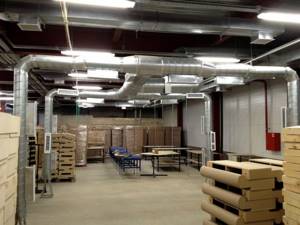
How to effectively reduce indoor humidity:
- Change the layout or design of the ventilation system. As a rule, they change the natural inflow to a forced one.
- After replacing natural ventilation with mechanical ventilation, you should install a fan coil unit - a ducted air conditioner. It is also recommended to increase efficiency with the help of moisture absorbers, or, in other words, dehumidifiers. Please note that this option is relevant for the winter period.
- As for the hot summer season, here the owners will need to install two double-circuit fan coil units, which will cool the incoming air masses and then heat them.
- The next stage is the installation of monoblock dehumidifiers. The productivity of special moisture absorbers should be 2000-3000 m³/h. The equipment is fixed over problem areas.
To finally solve the problem in large warehouses, commercial premises or greenhouses, it is necessary to reduce the air exchange rate. Then the humidity level can be reduced to 30%.

Ventilation
One of the most common causes of excess moisture is improper operation of ventilation systems. When ventilation works as it should, moist air enters the hood and is replaced with fresh, street air.
And if the ventilation is clogged or done incorrectly, then the air simply stops circulating. Therefore, try cleaning the ventilation or replacing it with a new one.
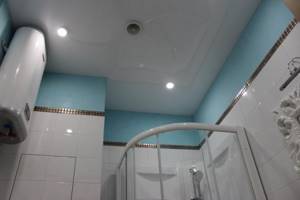
Causes of dampness in the room
There are many sources of moisture in the house:
- shower, bath;
- washing clothes, drying them in the apartment;
- aquariums;
- plants;
- groundwater;
- external environment;
- people's breathing.

Among the main reasons for increased humidity are the following:
- Natural ventilation is disrupted. This is the most common reason. It is often associated with replacing windows with plastic ones. Unscrupulous manufacturers may save money and not provide the product with a special ventilation system. Such windows are too sealed and simply do not allow moisture to escape from the home. Condensation appears and mold forms.
- The foundation and walls are poorly insulated from moisture. This is due to a violation of the construction technology of a residential building. With such errors, the foundation transfers moisture to all the walls, and they evaporate it into the room. Such defects are practically irreparable.
- Oddly enough, the third most common cause is salt. It can be added to the foundation in winter to make it strong even in frost. If there is salt in concrete walls, they will be constantly wet. In this case, you need to be patient. After a few years, the walls will finally dry out.
- Frequent rains. At the same time, dampness from the street moves into the house.
- Aquariums, home fountains, waterfalls. They are best placed in rooms with a dry climate.
- Drying clothes in the rooms and kitchen.
- The windows do not face south. A shady location increases humidity.
- Weak central heating in the apartment.
- Leaking roof.
Source of moisture
Sources of moisture in the apartment:
- precipitation: rain, melting snow, condensation can enter the apartment through a leaking roof, through wall pores and unsealed seams (especially if the wind, improper roof overhang or defective drainage constantly direct precipitation onto the wall);
- stagnation of water in the apartment: leaking plumbing equipment, swimming pools, baths, aquariums, including those located on the floor below; the same effect is achieved by running a bath or taking a long shower;
- the greenhouse effect from poor ventilation of windows (condensation accumulates on the glass), an abundance of indoor plants, especially if they need abundant watering;
- The breathing of people, animals, and plants also increases humidity - usually this factor is not noticeable, but in cramped and / or poorly ventilated rooms it will be noticeable.
Near a private house there may be chambos or septic tanks that saturate the grant with moisture. As a result, the basement becomes very damp and mold develops in it. Another source of moisture in the basement and on the 1st floor is a split blind area (a waterproof covering located around the perimeter of the house). Moisture from the soil and precipitation will seep into the house or basement.
An unheated room is a refuge for dampness. Ideally, the walls of an apartment or house should be heated to at least half their thickness, then the place where condensation forms will go outside (to the street). In frozen walls, the place where condensation forms is shifted to a warm area, and is often even located on the surface of the walls on the residential side. The problem is aggravated by poor ventilation of the premises.

Housing where no people live or which is not heated enough begins to become damp very quickly: the wall decoration is destroyed on average in two seasons. In addition, in addition to natural wear and tear, the structure loses an additional 5% of its strength every year due to dampness.
Improper insulation also causes dampness. The main mistakes are an insufficient layer to provide warmth, and poor materials with zero vapor permeability.
To properly insulate an apartment, you can use one of two options:
- The thickness of the polystyrene insulation layer is within 10-15 cm (and this is relevant for any region of the Russian Federation).
- Use vapor-permeable material as insulation, for example, ecowool, mineral wool. This will make it possible to ensure that moisture in the walls is removed.
How dehumidification tablets work
The kit consists of an absorbent tablet, which is placed in a special holder. A tablet of numerous crystals that absorb excess moisture from the air, they are placed in a plastic case.
By the way, we also recommend to your attention useful material about
plants that purify the air in the apartment
.
During operation, the tablet acts as an adsorbent that absorbs liquid from air masses. Subsequently, the moisture is transformed into a saline solution, which flows into a reservoir to drain the accumulated liquid.
This entire structure must be placed on a flat surface at a distance of at least 10 cm from the nearest wall. Do not install it near a heat source. It is recommended to choose places that are inaccessible to children and pets. One device is enough for a room of up to 20 m².
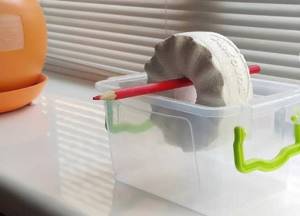
Air dehumidification tablets
Air dehumidifying tablets also effectively prevent the spread of fungal mold spores and eliminate the effect of condensation on the surfaces of windows, walls, and household items. Get rid of the unpleasant smell of dampness in the house. Change the tablets every 2-3 months after they are completely dissolved.
Expert opinion
Nikonorov Vladimir Alekseevich
Our expert. Specialist in the field of air conditioning and ventilation with 10 years of experience.
Ask a Question
Use absorbent tablets in areas most susceptible to condensation - the bathroom, kitchen, garage, attic and basement. The use of a drying device in these “dangerous” areas will be most effective.
Ways to reduce humidity in your home
You can reduce humidity using various means, but first it is important to identify the exact reason for its increase in your home.
- High air humidity may be temporary, for example during cooking. In this case, ventilation will help. You can use available means, for example, turn on the heater. The main thing is to ensure good circulation and oxygen access. The air flow in the room should be especially powerful if moisture begins to condense on the walls. This can be achieved using a regular draft.
- A damp room should be regularly heated with a heating device.
- Poor ceiling condition can also lead to increased dampness. It's not easy to dry it. You can try to plaster again. At the same time, the furniture is taken out so that moisture does not absorb into it.
- PVC windows can significantly limit the access of air into the home and cause dampness in it. When ordering frames, specify the presence of a special ventilation system.
- There are modern means for treating rooms that reduce humidity (for example, “Stop-moisture”). They contain absorber crystals, an absorbent. The moisture ends up in special containers.

So, you can improve humidity indicators yourself:
- Ensure sufficient sunlight penetration into the room. Open curtains regularly. There should be no bulky flowers on the windowsills.
- Ventilate more often (three times a day for half an hour). Ventilation is especially effective in summer and winter, when the air outside is as dry as possible. You can leave the kitchen window open at night.
- Ensure proper ventilation. Check whether the ventilation window is closed and whether the system itself is working.
- If it is very damp, you can turn on a household heater. It will quickly heat and dry the air.
- Drywall and wood are building materials that prevent high humidity. Use them when making repairs.
- Even walls can be covered with plasterboard. Waterproofing plaster will also help solve the problem.
- Insulate the walls outside. This will help, unless of course a flooded basement led to dampness.
- Install a hood in the kitchen. Turn it on every time you cook. Cover kitchen utensils with lids.
- Candles, a hairdryer, and even indoor plants (that don't require frequent watering) will help dry out the room's "atmosphere" a little.
- If dampness has settled in the closet, iron the clothes with a hot iron.
General Tips
Both in the case when external causes contributed to the formation of dampness, and in the presence of internal sources, general advice is valid that will help quickly dry the home and return the microclimate to normal levels.
- In the bathroom, install additional forced ventilation and turn it on every time during and after taking a shower or bath and when drying clothes;
- At least for several hours after taking a shower, leave the bathroom door open;
- In a kitchen where there are elevated temperatures and high humidity, be sure to install a hood and turn on the appliance even when you are just boiling the kettle;
- Ventilate the premises more often. Modern fittings for plastic windows have a useful function – micro-ventilation. It allows you to comfortably ventilate your home even in the cold season;
- In summer, try not to shade window openings, but rather open the curtains and let sunlight into the house;
- In spring and autumn, when the heating system is inactive, warm up your home using additional heating devices. It is during this period that the humidity level rises to its maximum. You can use electric fireplaces, oil or infrared heaters, and heat fans. It is better to purchase one small device, but for each room separately. An additional electric heated towel rail can be installed in the bathroom. Some people recommend using heat guns, but remember that they can significantly increase the temperature of the room and heat up everything in it;
- Simple ingredients such as table salt or sugar will help absorb excess moisture. Place containers with this filler in inconspicuous places as an aid. Or use silica gel;
- After wet cleaning, wipe all surfaces dry;
- If the apartment has old wooden windows, be sure to seal them with special paper for the winter and insulate the cracks with foam rubber. This will not only keep the heat inside the home, but also prevent the penetration of moisture from the outside;
- Buy a device called a dehumidifier from a hardware store. It will help quickly remove excess moisture from the air. Some dehumidifier models are equipped with a built-in hygrometer - a device for measuring air humidity levels. This is very convenient, because you can clearly see that the dehumidifier is really working effectively. And in order not to turn the device on/off every now and then, but to easily maintain a constant level of humidity in the apartment, it is better to purchase automatic models;
- Instead of a dehumidifier, you can use a regular air conditioner, which has a dry mode.
Features of eliminating high humidity in summer, winter, and off-season
In the warm season, simple ventilation with good air exchange will help reduce the humidity in the room. To do this, just open the windows.
But in the off-season and winter, this option is not suitable due to inefficiency. When there is high humidity outside, it is better to use other methods to eliminate moisture in the house:
- heating;
- dampness tablets;
- dehumidifiers.
Regardless of the time of year, it is necessary to remember about preventive measures to prevent high humidity.
Breathable materials
Increasingly, we use artificial building materials to furnish our homes, forgetting that they absolutely do not “breathe”, and therefore help retain moisture in the room. Whereas natural materials, such as wood, or more inexpensive drywall, on the contrary, are capable of both taking and releasing moisture, leveling the microclimate.
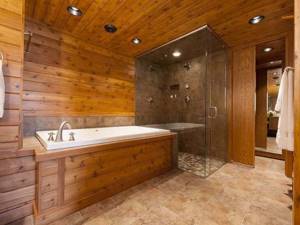
Plants
Its increase can be influenced by a large number of indoor plants in the room.

In this case, there is only one solution - to take the flowers outside for a while until the level returns to normal.
You may have heard of houseplants that are known to absorb moisture from a mixture of gases. With their help you can get rid of humidity in the room.
Tropical plants called epiphytes—such as ivy, lily, reed palm, and Boston ferns—get all their water from the air rather than through their roots.
All plants release more water into the atmosphere than they absorb. Think about terrariums and greenhouses, where the air is always humid and less likely to get into the apartment.
Insufficient heating
If you have an apartment with individual heating, then the problem of high humidity is easily solved. In winter, you can regulate the heat supply yourself, reducing or increasing it as needed, but without sudden changes that will aggravate the situation. In damp and humid weather, you need to turn on the heating to dry.
What to do if, with centralized heating, the apartment is not warm enough and because of this the humidity rises?
- Cold pipes may be the result of a lack of heat supply by boiler houses or the initiative of neighbors who decided to remove the bypasses. The solution is to contact utility services.
- Installed decorative grilles on radiators reduce heat transfer by a quarter. It's better to give them up completely.
- Paint on batteries can also reduce heat transfer by 10%; to avoid this, it is necessary to remove the previous layer before painting.

Prevention measures
Preventative measures to prevent high humidity in the house include the following:
- Carrying out waterproofing work to prevent moisture from entering rooms - eliminating leaks, ensuring the tightness of windows, sealing floors, insulating walls, etc.
- Cooking food must be covered. This will prevent the formation of steam and, as a result, an increase in humidity.
- The premises should not be used for other purposes.
- It is necessary to regulate the permissible number of water containers in one room.
- Installing a hood in the kitchen will reduce moisture levels in the air.
- Checking the functionality of the ventilation system and repairing it, if necessary.
- If the room is damp, it is not advisable to place aquariums in it.
- Choosing reliable plastic windows is one way to prevent excess humidity.
- It is best to move drying clothes outside or to the balcony, avoiding hanging wet things indoors.
Causes of the problem
Constantly high humidity in the room must have a specific reason. In some cases, the source of moisture can be determined quickly.
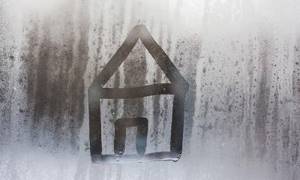
- leaking roof;
- violation of the integrity of the outer wall, the tightness of the slabs;
- flooding;
- ventilation system defect.
Internal reasons for the appearance of high humidity include violation of operating rules:
- the location of several aquariums or other open containers with water in a room that is not designed for this;
- growing tropical or other plants that require abundant watering in large quantities;
- frequent drying of large amounts of laundry;
- cooking food in open pans;
- lack of sealing of windows;
- leaks in pipes (sewage, water supply, heating).
If a source of high humidity is identified, it should be eliminated.
Clothing and carpets
You can dry things in the bathroom only if there is good ventilation. Otherwise, you should not hang clothes there, but as an alternative, choose a balcony or shade outside. An even bigger mistake would be to hang wet clothes in hallways or living rooms. Such rooms rarely have good ventilation.
All carpets are capable of collecting moisture over time. The higher the humidity level, the faster they accumulate liquid inside themselves. A moldy or wet carpet with an unpleasant odor should most likely be taken to an industrial dry cleaner or paid for by professionals to come to your home and carry out the work right on site. This can be called a very effective way to reduce humidity in an apartment for those who have such floor coverings.
Dehumidifier: operating principles
We described in detail how to dehumidify the air in an apartment without a dehumidifier, but in some cases you cannot do without this device. A dehumidifier is used if the humidity in the apartment is too high, and other methods of combating it have not helped.
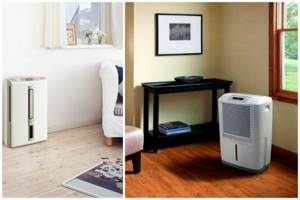
- Its operation is based on the absorption of air through the evaporator. The temperature inside the device is lower than in the room. Moisture condenses on its walls and flows into the container. In this case, the dried stream flows back into the room.
- So, this device will help you quickly dry out too humid air in your apartment. The desiccant can be portable or stationary. The latter have greater productivity. They are mounted on the wall, which saves room space. Portable ones have smaller dimensions, therefore their power is lower. When purchasing, you should clarify what the power of the device is. Choose a device with maximum power.
- You can try to assemble a dehumidifier yourself. To do this, watch the video after the article.
We have described in detail how to choose a dehumidifier for your home in this article.
Recommendations
combat high indoor humidity :

Without eliminating the root cause of high humidity in the house, any measures taken will only have a temporary effect and will not radically solve the problem.- If the moisture problem has been ongoing, the area should be inspected for mold growth. If fungus is detected, the apartment (house) should be treated with special means.
- If, after eliminating high humidity in the room, the smell of dampness continues to persist, you can use purchased or natural flavors - coffee beans, vinegar, essential oils, etc.
Why is dampness dangerous?
Indoor air humidity is one of the main criteria for a healthy microclimate.
For a comfortable stay, it is necessary that the relative air humidity be at the level of 45-60%. But what to do when it becomes too much? The main signs of excess humidity are:
- constantly foggy windows;
- unpleasant smell of dampness and mustiness;
- the appearance of mold and mildew.
All this leads not only to property damage, for example, peeling plaster, peeling wallpaper, and swelling of furniture, but also causes direct harm to the health of residents.
Preventing dampness in the home
For prevention, it is worth remembering the following tips:
- After washing, showering, taking a bath, ventilate the bathroom.
- You should not dry clothes in the apartment. There is a balcony for this. Modern washing machines also have a drying function.
- Install plastic windows with ventilation.
- Avoid using an aquarium, fountain or indoor waterfall.
- Among indoor plants, choose succulents and cacti. They do not need frequent watering.
So, high humidity in apartments is a very common problem. Follow simple prevention tips and you will not encounter this extremely unpleasant phenomenon.
Eliminating moisture due to roof problems
There are two main reasons:
- Gutter - a properly installed system serves to drain precipitation from the roof. This protects the walls and foundation from their impact. You should know that the drain is made with a slope, and all parts are hermetically connected. Water must be drained into the stormwater system.
- Roof. According to the technology, the roof must have double waterproofing, insulation, and a gap for natural ventilation of the under-roof space (this is the place where condensation most often forms). To assess the condition of the roof, it is better to contact a specialist who will determine the quality of the materials and whether they are installed correctly. It will also help to correctly eliminate shortcomings.
We looked at how you can get rid of dampness in a house, depending on the walls, foundation, roof, and communications. But there are features of dealing with high humidity, depending on the material from which the building is constructed.
